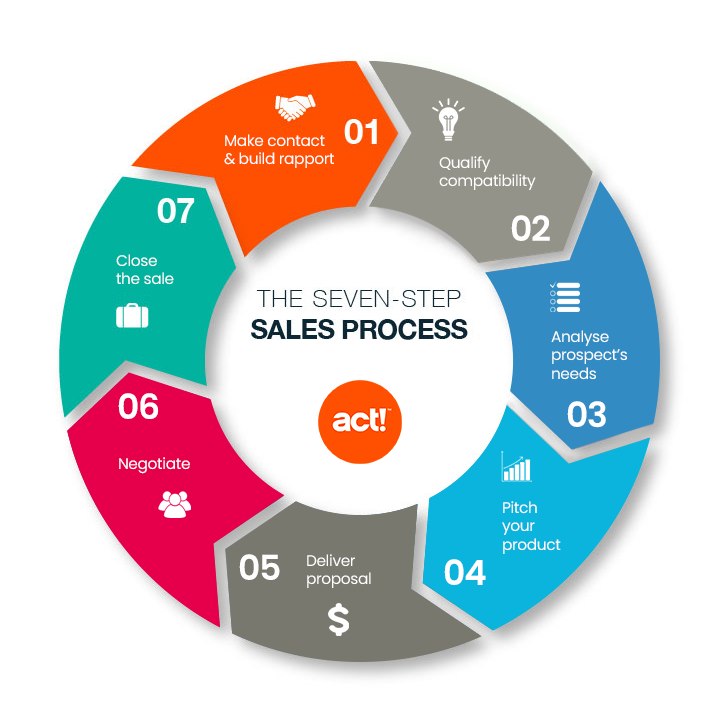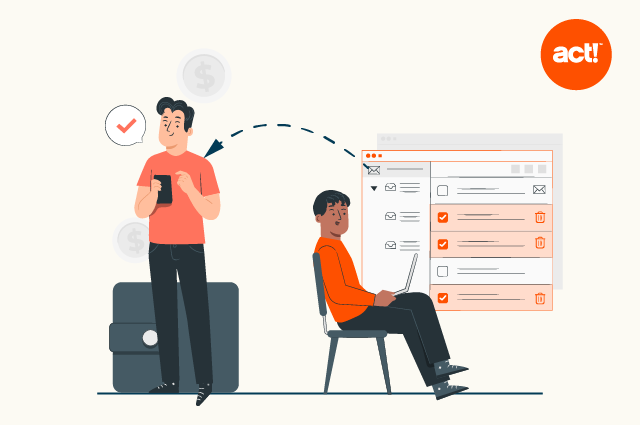Have you ever stopped to think about your sales cycle? The fact is, many small businesses don’t. Often they’re just too busy trying to keep the business running from day to day. But the fact is, sales don’t “just happen”. To reach new customers, retain existing ones, and increase your revenue, it’s important to know what a sales cycle is and how to make it work for you.
Additionally, understanding the sales cycle is crucial when training new sales reps and measuring your sales efforts, and defining your sales strategy and roadmap.
What is a sales cycle?
A sales cycle is a series of specific steps needed to acquire new customers. It includes different stages that typically align with your sales funnel and designate an activity your sales reps must complete before advancing the sale toward a close. Each step or stage has a particular purpose.
The seven typical stages include:
- Step 1: Initial contact
- Step 2: Qualify compatibility
- Step 3: Analyse needs or wants
- Step 4: Make the pitch
- Step 5: Deliver the proposal
- Step 6: Negotiate
- Step 7: Close the deal

How do these stages work?
Sales cycles differ from one company to the next. Some cycles may be longer or shorter. For instance, prospective customers looking to purchase a new car will likely take longer to decide, or have more hesitations than someone purchasing a t-shirt. But no matter how long your sales cycle is, you should think about how your potential clients progress through each of the stage of your sales cycle so you can provide the best possible experience. (And, ideally help them progress quickly until you make the sale.)
1. Initial contact
This is where the sales process begins. In this stage, you’ll have already identified your target audience by creating buyer personas. Buyer personas are descriptions of your ideal customers, and provide more insight about their interests, needs, pain points, and how you can help them.
Sales professionals use buyer personas to identify leads and cold prospects who closely match your ideal customer profiles. To find cold prospects (i.e. those who aren’t marketing qualified leads (MQLs)) your reps might search social media sites like LinkedIn or look through referral sources. This is one way to put together a list of potential leads to contact. Of course, the more refined your sales funnel, the more MQLs you can provide to your sales reps. That means they can spend less time prospecting and more time selling.
2. Qualify compatibility
Once your reps have a list of leads, they need to determine where the potential customers are in the buyer’s journey. Are they aware of what they need, or they are still searching for a solution that solves their problem? This will tell your salesperson what the prospect needs next. For example, if they accessed an offer from your website or social media page, they may be ready to discuss your product in more detail. Or maybe the prospect is still doing research about a problem and isn’t ready to choose a product or service yet. Perhaps this prospect needs more time before they’re qualified and ready to advance through the rest of the sales process.
Remember — Once compatibility is confirmed, sales reps should make that first contact as soon as possible so your company will be a contender when the prospect is ready to buy. In fact, making contact within an hour or less has been found to be optimal. Automated marketing and CRM solutions can help prioritise these follow-ups to ensure potential customers don’t fall through the cracks.
3. Analyse needs or wants
Once you or your reps have contacted a lead, perhaps by cold calling, it’s time to begin qualifying them. ( Quick tip: You can often simplify this step by ensuring lead capture forms on your website gather the right information to determine if prospects are a good fit for your company.)
In this stage, you’ll want to ask decision makers a series of questions to first find out what they want or need, and their budget. This questionnaire is also known as the BANT (Budget, Authority, Need, and Time) model that helps companies quickly and accurately assess if the lead is ready to move forward and make a purchase. If not, the BANT approach prevents you from investing too much time on the wrong prospects.
4. Make the pitch
If the lead is interested and qualified, this is the point in the selling process when you begin nurturing them until the timing is right to close the deal. Personalisation during this stage is especially important to start building a relationship. Instead of focusing on your product features, focus on prospects’ needs, handling objections, and how you can help them solve problems. Whether you provide a sales presentation, create a personalised nurture email campaign administered by your integrated CRM and marketing automation platform, initiate phone calls or retarget social media ads to these leads, the key is to keep prospects engaged so your company stays top of mind.
5. Deliver the proposal
Leads that sign up for demos or trials and are inquiring about pricing and are typically ready to make a purchase. At this point, it is appropriate to make a sales pitch that concludes with a competitive offer.
6. Negotiate
Expect leads to push back once you’ve made an offer. They might argue that the price is too high compared to your competitors’ rates. Or maybe the proposal doesn’t include key products or services they want. Many times you can overcome these objections by adding something of value to the prospect, but at minimal cost to you, such as a longer support contract or free delivery. Make sure to track these negotiations so you can improve your rep closing techniques and prepare them for future client engagements.
7. Close the deal
Now it’s time to make the sale! The good news is, closing the deal should happen naturally if you’ve followed all of the previous steps. It might sound obvious, but just make sure any and all paperwork is complete and accurate, so all the customer has to do is sign (or sign up). After all your hard work, you don’t want to drop the ball (and lose the customer) because of errors at signing.
How to Improve Your Sales Cycle
Every business wants to accelerate its sales cycle. Here are some ways to refine your marketing processes and sales techniques so you can close deals faster:
- Reduce non-sale activities through automation. This frees up your salespeople to spend more time on sales and repeat business activities.
- Manage leads effectively, so you never forget a follow-up or miss a touchpoint. Don’t let valuable leads fall through the cracks. Track reminders in your CRM help keep your reps on track and your sales pipeline accurate.
- Your reps should always ask for small commitments as part of the sales process along the way. This can help accelerate the sale or draw out potential objections in advance of the final close.
- Simplify scheduling by choosing a CRM that has meetings and follow-up scheduling built in.
- Leverage proof points like customer success stories and testimonials to proactively promote the benefits of your product, handle potential objections and boost your company’s visibility.
- Train your sales team and reinforce what they learn with regular coaching. This will help them stay creative and competitive.
Next step: See how Act! CRM can improve your sales process
If you’re looking for the right CRM and marketing automation solution to help with lead generation, drive your sales cycle and manage your customer relationships, discover how Act! CRM can help you make data-driven decisions across every step of the sales process. Try it free for 14 days!





